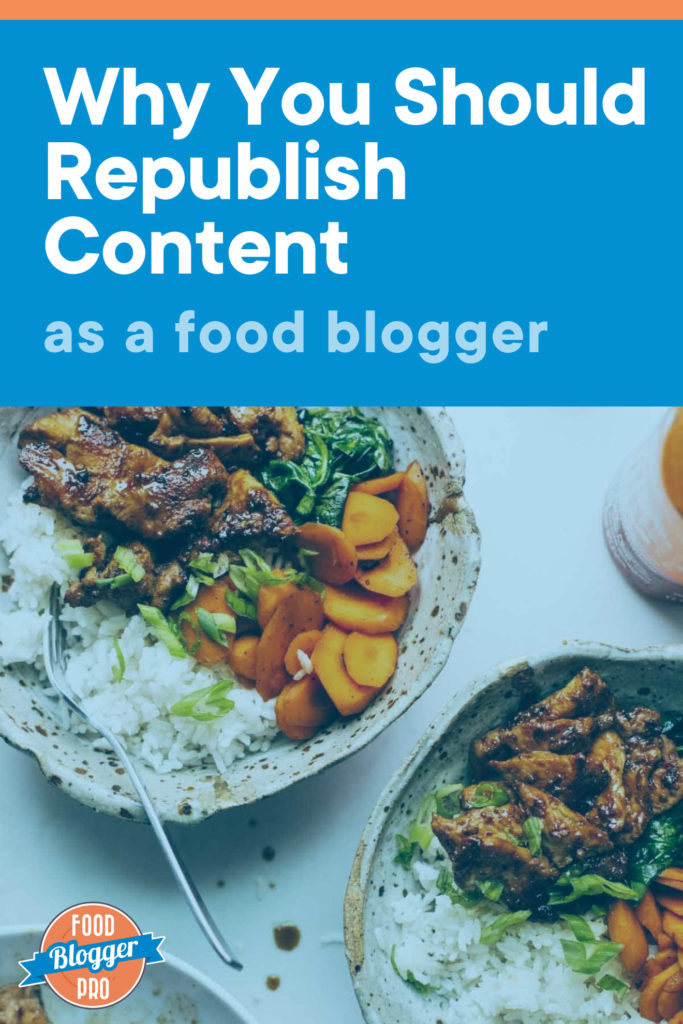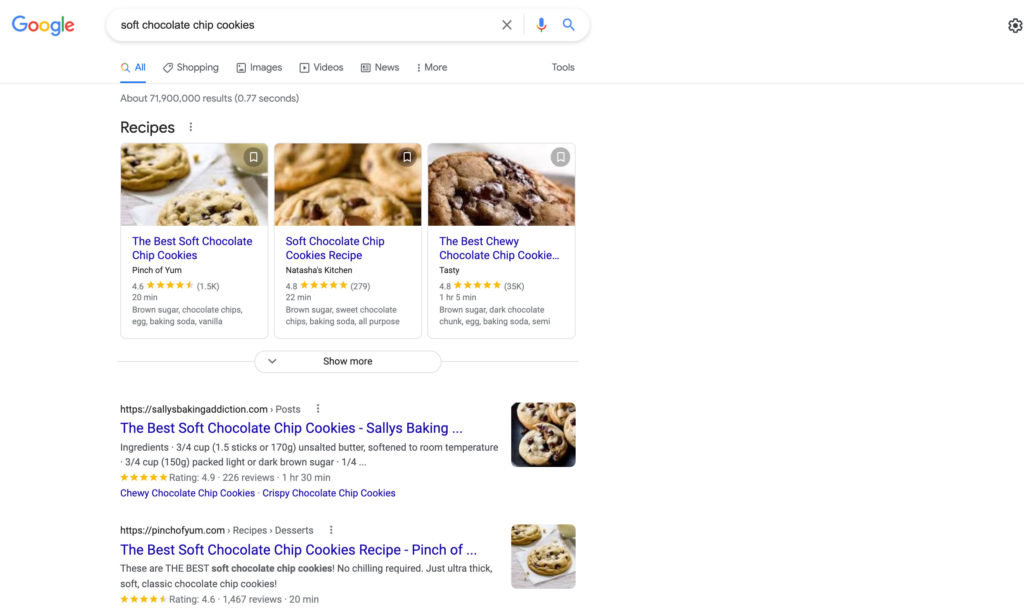
Hello, hello, and welcome to Part 1 of our Republishing Content Series!
Over the next few weeks, we’re going to be focusing on why you should be republishing posts on your blog to get the most out of your existing content.

We’ll be covering:
- Why you should republish content (this post!)
- How to identify which posts to update and republish
- What exactly to update when republishing content
Without further ado, let’s kick things off by going over a few reasons why you should consider republishing content as a food blogger:
1. It can save you time and be an easy win.
As food bloggers, we oftentimes have a lot on our plates (pun intended). We’re constantly testing recipes, shooting photos, filming videos, drafting blog posts, sharing new content on social media… the list goes on and on.
But when it comes down to it, creating new content can take a lot more time than we realize. Over the years, we’ve talked to a lot of food bloggers on The Food Blogger Pro Podcast, and we’ve heard time and time again that it can take hours (if not days!) to produce one single blog post.
By republishing some old content on your blog, you’re able to gain back some of the time that you would have spent creating a post entirely from scratch. Republishing specific pieces of content can help you be strategic with your time and help you maximize your productivity as a food blogger.

2. It refreshes older content you want your audience to see.
If you’ve been blogging for a while, you probably have quite a few posts on your site that you’ve created and published, but then haven’t touched since.
And for some of those posts, maybe the photos are a bit blurry and the copy is outdated. Or maybe you didn’t quite understand the basics of SEO back then, so the post isn’t optimized as much as it could be. Why not make some small updates to that post and republish it to the front of your blog?
Republishing these older posts can help breathe some new life into some of your older content and bring it front-of-mind for your audience.
3. It can potentially improve your Google rankings.
If you have a post that’s just on the edge of ranking well for a keyword, you can potentially boost that ranking by making some small updates. In turn, this can drive more traffic to your site, potentially increasing your revenue as well.
It’s usually easier to get more traffic from a post that’s almost performing well rather than creating a brand new post and hoping it performs well.

Curious to see how this works? Let’s take a look at this Spicy Sofritas Tofu recipe on Pinch of Yum. It was originally published way back in 2014, but the Pinch of Yum team republished it in 2020.
Before republishing, they changed the recipe title from ‘Spicy Sofritas Veggie Bowls’ to ‘Spicy Sofritas Tofu Recipe’ to help people find it a bit more easily on Google. They also updated the copy of the post, added in some more headings, and even added videos to provide readers some helpful visuals when making the recipe.
And the result? The post jumped from position 14 to position 4 on Google. And in 2021, it’s now ranking first on Google for the keyword ‘spicy sofritas tofu.’ That’s the power of republishing content in action!
In the next post in this series, we’ll dive a bit deeper into this topic and explore how to determine the rankings of your posts, so stay tuned for that.
But keep in mind that republishing content doesn’t automatically guarantee better rankings! As we like to say, Google does what Google wants — all you can do is optimize your content to the best of your ability, then be patient and leave it in the hands of Google.
4. Small changes you make now can have a big impact on the growth of your blog.
Here at Food Blogger Pro, we’re big fans of the idea of 1% infinity, and we believe that long-term, noticeable growth comes from taking consistent, small, and intentional actions over time.
So as you’re going through and making small improvements to your older posts, these small changes can have a multiplier effect on the growth of your blog.
Optimizing one post can help bump its position in search rankings, causing more people to stumble upon your blog, which can help you grow your email list, gain social media followers, and increase your revenue over time.
Republishing your content and taking these small steps to make your posts the best they can be will help you make progress on achieving your overall traffic and growth goals.
And that’s a wrap for Part 1 of our Republishing Content Series!
When it comes down to it, republishing posts on your site can help you save time, optimize your existing content, and reach your goals. And in this series, we hope to give you the knowledge and tools you need to republish posts on your blog with confidence.
However, you don’t necessarily want to update content that’s already performing well. Up next, Alexa will cover how to identify which posts you should update, as well as which ones you should leave alone.
Now we’re curious: Do you like to republish content on your blog? Let us know in the comments!
Just curious, when you say republish do you mean to update an existing post or republishing it as a totally new post with a new date? Should you then remove the old post or leave them both up? Thanks!
Good question, Cheryl! We mean updating an existing post and then adjusting the date on it to republish it to the front of the blog. You wouldn’t want to create an entirely new post from scratch.
We’ll go over what posts you should consider republishing, as well as what exactly to update, in the next few posts in this series. Stay tuned!
Thank you for this reminder. Life is busier than I expected right now, so this will help me a lot.
We’re glad you enjoyed the post, Nadia! Republishing content is a great way to save some time when life gets busy.
This is something I’ve been confused about. Can you be more specific as to what to do to repost, (for some of us who need extra help)? Do I leave the name of the recipe the same, followed by a date? Do we post the original post date on the post? How do I pin it to the front of my blog? I’ve been wanting to know this for a long time. Help please!!
Hi, Cindy!
When republishing a post, you’d typically want to leave the name of the recipe and the URL the same while updating some of the internal content (like the copy, pictures, etc.). If you’d like, you could then change the published date of the post to move it to the front of the blog. Depending on your theme, there are some settings you can enable (or some code you can add) to show both the original published date and the modified date. We’ll chat more about this in the next few blog posts!
In addition, we’ll go over what posts you should consider republishing, as well as what exactly to update, in the next few posts in this series. Those posts will be coming this week and next, so stay tuned!
If my post has had some hits since publication and is ranking for keywords I don’t want to republish and lose that “google juice”! So I’ve been doing major updates, converting to blocks and submitting it to the search console to be recrawled. What would warrant republishing? And would I lose that google juice? I usually only republish if it has new photos in addition to an update and only a handful of hits.
Great question, Terri! In the next post in this series, we’ll be focusing on how to identify which posts you should republish, so stay tuned for that. It’ll be on the blog tomorrow!
As a general rule of thumb, we don’t recommend updating any posts that are doing really well (especially if they’re ranking higher than position 4 on Google). Since that piece of content is already ranking well, you’re doing something right, and it’s entirely possible that you could update and republish that post post and see a decrease in search position. Instead, you can use that piece of content to see what makes it so valuable for that keyword and try to replicate it on some of those better candidates for updates and republishing.
I hope that helps!
To all the dedicated bloggers out there, thank you for sharing your passions, expertise, and creativity with the world. Your tireless efforts to create engaging content, inspire, and educate others do not go unnoticed. Your blogs are a valuable resource, a source of comfort, and a beacon of knowledge. Keep writing, sharing, and shining your light!